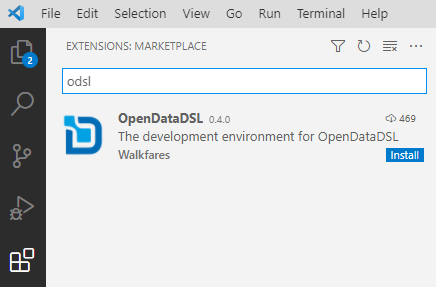OpenDataDSL Developer
QuickStart Track
This quickstart track will help you learn how to code in the OpenDataDSL programming language.
Introduction
Welcome to the OpenDataDSL developer quickstart track!
Here you will start with the fundamentals of the ODSL programming language and quickly jump into the primary domain of this language - data management.
If you have programmed in other 2nd or 3rd generation languages at any level, you will easily grasp the core elements of the language, whilst appreciating the data management extensions.
Preparation
This quickstart track requires some preparation in order to follow along with the content.
Visual Studio Code
If you don't already have Microsoft VSCode installed, install it now using this link

ODSL Extension
Open VSCode and click on the extensions icon in the Activity Bar on the left or press (ctrl-shift-X) and then search for odsl

Click on the Install button to start the installation of the ODSL extension
Once installed, opening or creating a file with the extension .odsl initiates the ODSL editor
Let's get started!
Basic core language syntax.
An introduction to variables, looping, conditional statements and testing.
Get StartedAn overview variable types including geometry, dates, durations and objects.
Get StartedA tour of the built-in functions and tutorial on how to create your own.
Get StartedInteracting with remote services.
Connect to the remote services, creating some data and storing it in the cloud.
Get StartedA comprehensive tutorial on finding and filtering data including geo-spatial queries.
Get StartedAn in-depth guide to working with TimeSeries and Curve data.
Get StartedLoading data, analytics and automation.
Utilise aggregation pipelines and statistical functions to analyse your data.
Get StartedA tutorial on extracting data from remote services, transforming and loading it.
Get StartedA tutorial taking you through automation using workflows and processes.
Get Started